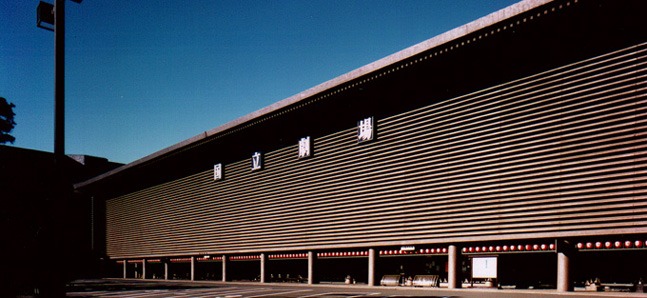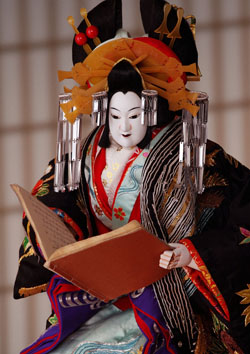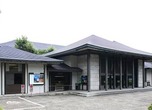
National Theatre
Posted: Tue May 18 2010
Just like Noh (a classical form of Japanese musical drama popularised during the Muromachi period), the origins of ningyo-joruri (traditional Japanese puppet theatre more commonly known as bunraku) can be traced back to the 14th century – a period in which the power of the shogunate was beginning to weaken, and various influential figures from different parts of Japan where looking to further their own names and more modern ideas.
Amongst those times of political unease, the result was that the ordinary people of the day – farmers and tradesmen – were able to express themselves with more freedom than before, playing more of an active role in helping to shape the world around them.
Traditional ningyo-joruri-bunraku consists of three elements: music performed on a shamisen (a banjo-like three-stringed musical instrument), a tayu (a narrator who chants the tale in tune with the shamisen), and dolls (ningyo) controlled by highly skilled puppeteers. The oldest of these three elements is the dolls – their history can be traced back as far as a puppeteering ensemble called Kairaishi, that was known to have been active during the 12th century.
Joruri, the form of performing arts involving the recitation of a tale accompanied by shamisen music, began in the closing years of the Muromachi period and went on to gain widespread popularity throughout Japan. In the 17th century joruri met with ningyo (puppets) and gave birth to a new form of public entertainment called ningyo-joruri.
Ningyo-joruri has had a lasting impact on Japanese arts, with such reaching influence as the renowned Japanese film entitled ‘Onnagoroshi abura no jigoku’ (English title: ‘The Oil-Hell Murder’), directed by internationally acclaimed film director Hideo Gosha. The film was actually based on a ningyo-joruri performance of the same name produced towards the end of the 17th century by legendary Japanese dramatist Monzaemon Chikamatsu – who originally wrote the work for the Takemotoza theatrical group in Osaka.
Amongst the numerous ningyo-joruri groups of the time, the actions of one particular group, called Bunrakuza (whose organisation could be likened to a modern day company), led to the naming of the National Bunraku Theatre, a theatre that was established in Osaka in 1984 and effectively signified the nationalisation of ningyo-joruri. In the wake of this nationalisation, the word bunrakuza, which was originally used to signify just a single group amongst many, became so closely associated with ningyo-joruri (formally called ningyo-joruri-bunraku) that the two words have become practically interchangeable.
In the same way that joruri came about in a time that could be thought of as Japan’s performing-arts renaissance period (the Muromachi period), ningyo-joruri-bunraku is a form of entertainment that came to fruition during the lively and prosperous days of the Edo period.
To add to its social relevancy, it’s said that Monzaemon Chikamatsu, the incredibly popular dramatist associated with ningyo-joruri, wrote his pieces for the young female hairdressers of the time – ladies who were referred to as the kamiyui. Believing that if his plays could capture the hearts of these flamboyant young women, who were a sort of Edo period career women who were often in vogue and earned enough money to live independent lives, then his works would surely be successful.
True to the original puppets, which were often draped in the elaborate costumes that were at the height of fashion at the time, the designs of the clothing worn by the puppets used in modern day bunraku performances remain completely unchanged since the Edo period. Another particularly interesting aspect of the ningyo-joruri-bunraku performances is that many of them were based on actual events, such as murders and social disturbances – meaning that these unique spectacles functioned not only as a form of public entertainment, but also often as a form of public media. The people of the day would crowd into the theatre to see each new performance with anticipation similar to that of a newspaper, talk show, or a gossip or fashion magazine.
In addition to being based on sewa-mono (contemporary tales concerning ordinary citizens), ningyo-joruri performances are also often based on historical tales of famous battles or stories involving samurai – known as jidai-mono – one of the most famous being ‘Kanadehon Chushingura’, a story based on accounts of the 47 ronin revenging the death of their master. The story was first performed as a ningyo-joruri play in Osaka, and is laden with nuances aimed at opposition of the shogunate, and is now televised annually towards the end of each year in Japan.
However, both jidai-mono and sewa-mono portray a time in which ordinary citizens and merchants – who until the Edo period were lorded over by the samurai – were increasingly able to expand their livelihoods, gain better positions in society and generally express themselves in a more open manner.
One of the most important things to note is that up until this time, the dissemination of news or ‘information’ had been almost entirely controlled by the ruling classes – and that anything pertaining to criticism of the shogunate was strictly forbidden. Whilst still paying due regard to ruling classes, ningyo-joruri was a channel through which the people of the day could express some of their true feelings.
If you’ve never seen a ningyo-joruri performance, it might initially seem that the music, puppets and the narrator are somehow out of sync. Take a little time to read a summary of the story before you go, then all you need do is trust the expert skill of the performers to bring each of the puppets to life, sit back and become lost in the show.
With much of Japan’s bunraku taking place at the National Bunraku Theatre in Osaka, chances to see performances in Tokyo are relatively limited. However, Tokyo’s National Theatre will be showing ningyo-joruri-bunraku until May 24. Tickets can be bought on the day, but to avoid disappointment it’s best to book in advance.
Both morning and afternoon sessions will be shown; however, for those who have never seen this type of show before, a good performance to start with might be the famous kabuki-derived piece ‘Renjishi’, which will be shown during one of the morning sessions. Full of variety and offering a wonderful chance to enjoy the movements of the puppets, the piece incorporates both a tale involving samurai and a tale involving ordinary citizens from the Edo period.

Schedule
Ningyo-joruri-bunraku Performance
Date: Until Mon May 24
Location: National Theatre
Time: First session: 11am open; Second session: 4pm open
Admission: First seating area ¥6,500 (students ¥4,600); second seating area ¥5,200 (students ¥2,600); third seating area ¥1500 (students ¥1,100)
Website: www.bunraku.or.jp/english.html
Telephone: (0750)07 9900, (03)3230 3000 (PHS, IP phone) National Theatre ticket centre
Note: Please call to inquire about ticket availability.
Tweets
- About Us |
- Work for Time Out |
- Send us info |
- Advertising |
- Mobile edition |
- Terms & Conditions |
- Privacy policy |
- Contact Us
Copyright © 2014 Time Out Tokyo














Add your comment